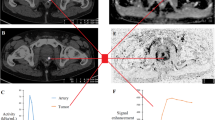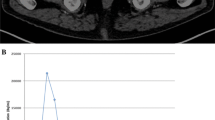Abstract
Purpose
11C-Choline-positron emission tomography (PET)/computed tomography (CT) is increasingly used in patients with prostate cancer. Another promising technique for assessment of tumor biology is diffusion-weighted MR imaging (DWI). The aim of the study was to compare the functional parameters standardized uptake value (SUV) in PET and apparent diffusion coefficient (ADC) value in DWI of lymph nodes in prostate cancer patients.
Procedures
Fourteen patients with prostate cancer underwent DWI at 1.5T and 11C-Choline-PET/CT. ADC values and SUVs of all lymph nodes larger than 5 mm (n = 55) were compared by using linear regression analysis. Performance of DWI and 11C-Choline PET was assessed by receiver operator characteristic curve analysis using histopathology or clinical follow-up as standard of reference.
Results
ADC values and SUV showed a moderate but highly significant inverse correlation (r = −0.5144, p < 0.0001). In lymph nodes with low ADC values, the dispersion of SUV was more pronounced. Moreover, a highly significant difference was observed for mean ADC values and SUV in lymph nodes considered as benign or malignant by follow-up/histopathology (ADC 1.60 ± 0.24 vs. 1.09 ± 0.23 × 10−3 mm2/s; SUV 1.82 ± 0.57 vs. 4.68 ± 03.12; p < 0.0001, respectively).
Conclusion
These pilot data propose the ADC value in DWI as a new potential imaging biomarker which might provide additional information on tumor pathophysiology compared to the SUV in 11C-Choline PET/CT.





Similar content being viewed by others
References
Gronberg H (2003) Prostate cancer epidemiology. Lancet 361:859–864
Soh S, Kattan M, Berkman S, Wheeler T, Scardino P (1997) Has there been a recent shift in the pathological features and prognosis of patients treated with radical prostatectomy? J Urol 157:2212–2218
Cagiannos I, Karakiewicz P, Eastham J et al (2003) A preoperative nomogram identifying decreased risk of positive pelvic lymph nodes in patients with prostate cancer. J Urol 170:1798–1803
Hricak H, Schoder H, Pucar D et al (2003) Advances in imaging in the postoperative patient with a rising prostate-specific antigen level. Semin Oncol 30:616–634
de Jong I, Pruim J, Elsinga P, Vaalburg W, Mensink H (2003) Preoperative staging of pelvic lymph nodes in prostate cancer by 11C-choline PET. J Nucl Med 44:331–335
Rorvik J, Halvorsen O, Albrektsen G, Haukaas S (1998) Lymphangiography combined with biopsy and computer tomography to detect lymph node metastases in localized prostate cancer. Scand J Urol Nephrol 32:116–119
Jager G, Barentsz J, Oosterhof G, Witjes J, Ruijs S (1996) Pelvic adenopathy in prostatic and urinary bladder carcinoma: MR imaging with a three-dimensional TI-weighted magnetization-prepared-rapid gradient-echo sequence. AJR Am J Roentgenol 167:1503–1507
Oyen R, Van Poppel H, Ameye F et al (1994) Lymph node staging of localized prostatic carcinoma with CT and CT-guided fine-needle aspiration biopsy: prospective study of 285 patients. Radiology 190:315–322
Wang L, Hricak H, Kattan M et al (2006) Combined endorectal and phased-array MRI in the prediction of pelvic lymph node metastasis in prostate cancer. AJR Am J Roentgenol 186:743–748
Wolf J, Cher M, Dall’era M et al (1995) The use and accuracy of cross-sectional imaging and fine needle aspiration cytology for detection of pelvic lymph node metastases before radical prostatectomy. J Urol 153:993–999
Harisinghani M, Barentsz J, Hahn P et al (2003) Noninvasive detection of clinically occult lymph node metastases in prostate cancer. N Engl J Med 348:2491–2499
Hricak H, Choyke P, Eberhardt S, Leibel S, Scardino P (2007) Imaging prostate cancer: a multidisciplinary perspective. Radiology 243:28–53
Krause B, Souvatzoglou M, Tuncel M et al (2008) The detection rate of [(11)C]Choline-PET/CT depends on the serum PSA value in patients with biochemical recurrence of prostate cancer. Eur J Nucl Med Mol Imaging 35:18–23
Reske S, Blumstein N, Glatting G (2008) [11C]choline PET/CT imaging in occult local relapse of prostate cancer after radical prostatectomy. Eur J Nucl Med Mol Imaging 35:9–17
Rinnab L, Mottaghy F, Blumstein N et al (2007) Evaluation of [11C]-choline positron-emission/computed tomography in patients with increasing prostate-specific antigen levels after primary treatment for prostate cancer. BJU Int 100:786–793
Husarik D, Miralbell R, Dubs M et al (2008) Evaluation of [(18)F]-choline PET/CT for staging and restaging of prostate cancer. Eur J Nucl Med Mol Imaging 35:253–263
Scattoni V, Picchio M, Suardi N et al (2007) Detection of lymph-node metastases with integrated [11C]choline PET/CT in patients with PSA failure after radical retropubic prostatectomy: results confirmed by open pelvic-retroperitoneal lymphadenectomy. Eur Urol 52:423–429
Eschmann S, Pfannenberg A, Rieger A et al (2007) Comparison of 11C-choline-PET/CT and whole body MRI for staging of prostate cancer. Nuklearmedizin 46:161–168
Yoshida S, Nakagomi K, Goto S, Futatsubashi M, Torizuka T (2005) 11C-choline positron emission tomography in prostate cancer: primary staging and recurrent site staging. Urol Int 74:214–220
Wesbey G, Moseley M, Ehman R (1984) Translational molecular self-diffusion in magnetic resonance imaging. II. Measurement of the self-diffusion coefficient. Invest Radiol 19:491–498
Koh D, Collins D (2007) Diffusion-weighted MRI in the body: applications and challenges in oncology. AJR Am J Roentgenol 188:1622–1635
Abdel Razek A, Soliman N, Elkhamary S, Alsharaway M, Tawfik A (2006) Role of diffusion-weighted MR imaging in cervical lymphadenopathy. Eur Radiol 16:1468–1477
Holzapfel K, Duetsch S, Fauser C et al (2009) Value of diffusion-weighted MR imaging in the differentiation between benign and malignant cervical lymph nodes. Eur J Radiol 72(3):381–387
Kim J, Kim K, Park B, Kim N, Cho K (2008) Feasibility of diffusion-weighted imaging in the differentiation of metastatic from nonmetastatic lymph nodes: early experience. J Magn Reson Imaging 28:714–719
Lichy M, Aschoff P, Plathow C et al (2007) Tumor detection by diffusion-weighted MRI and ADC-mapping—initial clinical experiences in comparison to PET-CT. Invest Radiol 42:605–613
Thoeny H, Triantafyllou M, Birkhaeuser F et al (2009) Combined ultrasmall superparamagnetic particles of iron oxide-enhanced and diffusion-weighted magnetic resonance imaging reliably detect pelvic lymph node metastases in normal-sized nodes of bladder and prostate cancer patients. Eur Urol 55(4):761–769
Hara T (2002) 11C-choline and 2-deoxy-2-[18F]fluoro-D-glucose in tumor imaging with positron emission tomography. Mol Imaging Biol 4:267–273
Klerkx W, Mali W, Peter HA et al (2009) Observer variation of magnetic resonance imaging and diffusion weighted imaging in pelvic lymph node detection. Eur J Radiol
Hickeson M, Yun M, Matthies A et al (2002) Use of a corrected standardized uptake value based on the lesion size on CT permits accurate characterization of lung nodules on FDG-PET. Eur J Nucl Med Mol Imaging 29:1639–1647
Thie J (2004) Understanding the standardized uptake value, its methods, and implications for usage. J Nucl Med 45:1431–1434
Soret M, Bacharach S, Buvat I (2007) Partial-volume effect in PET tumor imaging. J Nucl Med 48:932–945
Tuncel M, Souvatzoglou M, Herrmann K et al (2008) [(11)C]Choline positron emission tomography/computed tomography for staging and restaging of patients with advanced prostate cancer. Nucl Med Biol 35:689–695
Bruegel M, Holzapfel K, Gaa J et al (2008) Characterization of focal liver lesions by ADC measurements using a respiratory triggered diffusion-weighted single-shot echo-planar MR imaging technique. Eur Radiol 18:477–485
Holzapfel K, Bruegel M, Eiber M et al (2009) Characterization of small (</=10 mm) focal liver lesions: value of respiratory-triggered echo-planar diffusion-weighted MR imaging. Eur J Radiol
Low R, Gurney J (2007) Diffusion-weighted MRI (DWI) in the oncology patient: value of breathhold DWI compared to unenhanced and gadolinium-enhanced MRI. J Magn Reson Imaging 25:848–858
Shen S, Chiou Y, Wang J et al (2008) Diffusion-weighted single-shot echo-planar imaging with parallel technique in assessment of endometrial cancer. AJR Am J Roentgenol 190:481–488
Ho K, Lin G, Wang J et al (2008) Correlation of apparent diffusion coefficients measured by 3T diffusion-weighted MRI and SUV from FDG PET/CT in primary cervical cancer. Eur J Nucl Med Mol Imaging 35:493–501
Mori T, Nomori H, Ikeda K et al (2008) Diffusion-weighted magnetic resonance imaging for diagnosing malignant pulmonary nodules/masses: comparison with positron emission tomography. J Thorac Oncol 3:358–364
Palumbo B, Angotti F, Marano G (2008) Relationship between PET-FDG and MRI apparent diffusion coefficients in brain tumors. Q J Nucl Med Mol Imaging 53(1):17–22
Ackerstaff E, Pflug B, Nelson J, Bhujwalla Z (2001) Detection of increased choline compounds with proton nuclear magnetic resonance spectroscopy subsequent to malignant transformation of human prostatic epithelial cells. Cancer Res 61:3599–3603
Casciani E, Gualdi G (2006) Prostate cancer: value of magnetic resonance spectroscopy 3D chemical shift imaging. Abdom Imaging 31:490–499
Ramirez DM, Gutierrez R, Ramos M et al (2002) Increased choline kinase activity in human breast carcinomas: clinical evidence for a potential novel antitumor strategy. Oncogene 21:4317–4322
Ramirez DM, Rodriguez-Gonzalez A, Gutierrez R et al (2002) Overexpression of choline kinase is a frequent feature in human tumor-derived cell lines and in lung, prostate, and colorectal human cancers. Biochem Biophys Res Commun 296:580–583
Hara T, Bansal A, Degrado T (2006) Choline transporter as a novel target for molecular imaging of cancer. Mol Imaging 5:498–509
Katz-Brull R, Degani H (1996) Kinetics of choline transport and phosphorylation in human breast cancer cells; NMR application of the zero trans method. Anticancer Res 16:1375–1380
Provenzale J, Mukundan S, Barboriak D (2006) Diffusion-weighted and perfusion MR imaging for brain tumor characterization and assessment of treatment response. Radiology 239:632–649
Wang J, Takashima S, Takayama F et al (2001) Head and neck lesions: characterization with diffusion-weighted echo-planar MR imaging. Radiology 220:621–630
Hofer C, Laubenbacher C, Block T et al (1999) Fluorine-18-fluorodeoxyglucose positron emission tomography is useless for the detection of local recurrence after radical prostatectomy. Eur Urol 36:31–35
Nuñez R, Macapinlac HA, Yeung HWD et al (2002) Combined 18F-FDG and 11C-methionine PET scans in patients with newly progressive metastatic prostate cancer. Journal of Nuclear Medicine: Official Publication, Society of Nuclear Medicine 43:46–55
Morris MJ, Akhurst T, Osman I et al (2002) Fluorinated deoxyglucose positron emission tomography imaging in progressive metastatic prostate cancer. Urology 59:913–918
Agus DB, Golde DW, Sgouros G et al (1998) Positron emission tomography of a human prostate cancer xenograft: association of changes in deoxyglucose accumulation with other measures of outcome following androgen withdrawal. Cancer Res 58:3009–3014
Picchio M, Crivellaro C, Giovacchini G, Gianolli L, Messa C (2009) PET-CT for treatment planning in prostate cancer. The Quarterly Journal of Nuclear Medicine and Molecular Imaging: Official Publication of the Italian Association of Nuclear Medicine (AIMN) [and] the International Association of Radiopharmacology (IAR), [and] Section of the Society of Radiopharmaceutical. Chemistry and Biology 53:245–268
Torizuka T, Kanno T, Futatsubashi M et al (2003) Imaging of gynecologic tumors: comparison of (11)C-choline PET with (18)F-FDG PET. Journal of Nuclear Medicine: Official Publication, Society of Nuclear Medicine 44:1051–1056
Wyss M, Weber B, Honer M et al (2004) 18F-choline in experimental soft tissue infection assessed with autoradiography and high-resolution PET. Eur J Nucl Med Mol Imaging 31:312–316
van Waarde A, Jager P, Ishiwata K, Dierckx R, Elsinga P (2006) Comparison of sigma-ligands and metabolic PET tracers for differentiating tumor from inflammation. J Nucl Med 47:150–154
Sutinen E, Nurmi M, Roivainen A et al (2004) Kinetics of [(11)C]choline uptake in prostate cancer: a PET study. Eur J Nucl Med Mol Imaging 31:317–324
Farsad M, Schiavina R, Castellucci P et al (2005) Detection and localization of prostate cancer: correlation of (11)C-choline PET/CT with histopathologic step-section analysis. Journal of Nuclear Medicine: Official Publication, Society of Nuclear Medicine 46:1642–1649
Heesakkers R, Hovels A, Jager G et al (2008) MRI with a lymph-node-specific contrast agent as an alternative to CT scan and lymph-node dissection in patients with prostate cancer: a prospective multicohort study. Lancet Oncol 9:850–856
Author information
Authors and Affiliations
Corresponding author
Additional information
Ambros J. Beer and Matthias Eiber contributed equally to this paper.
Rights and permissions
About this article
Cite this article
Beer, A.J., Eiber, M., Souvatzoglou, M. et al. Restricted Water Diffusibility as Measured by Diffusion-weighted MR Imaging and Choline Uptake in 11C-Choline PET/CT are Correlated in Pelvic Lymph Nodes in Patients with Prostate Cancer. Mol Imaging Biol 13, 352–361 (2011). https://doi.org/10.1007/s11307-010-0337-6
Published:
Issue Date:
DOI: https://doi.org/10.1007/s11307-010-0337-6




